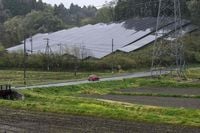Japan is making a bold leap into the future of renewable energy by heavily investing in ultra-thin, flexible perovskite solar panels, aiming not only to meet its ambitious climate goals but also to challenge China’s overwhelming dominance in the solar industry. This new technology, which could transform how solar power is harnessed across the mountainous landscape of Japan, represents a strategic push to secure energy independence and industrial competitiveness.
Perovskite solar panels are a game-changer for a country like Japan, where approximately 70 percent of the land is mountainous, leaving little flat terrain for traditional solar farms. Unlike conventional silicon panels, which are heavy and bulky due to their glass and metal frames, perovskite panels are ultra-light and flexible. They are created by printing or painting key ingredients such as iodine and lead onto surfaces like film or sheet glass, resulting in panels that can be just a millimeter thick and a tenth the weight of their silicon counterparts. This malleability allows them to be installed on uneven and curved surfaces, opening up vast new possibilities for solar energy deployment in areas previously considered impractical.
Japan’s advantage in this technology is underscored by its abundant iodine production—second only to Chile worldwide. Iodine is a crucial component in perovskite cells, making the country well-positioned to develop this industry domestically from raw materials to production and installation. Hiroshi Segawa, a specialist in next-generation solar technology at the University of Tokyo, emphasized the significance of this domestic capability, stating, “Perovskite solar panels can be built domestically, from the raw materials to production to installation. In that sense, they could significantly contribute to things like energy security and economic security.”
The government’s commitment is clear: it has pledged a generous 157 billion yen (approximately US$1.1 billion) subsidy to Sekisui Chemical Co., a plastic manufacturer, for a factory capable of producing enough perovskite solar panels to generate 100 megawatts by 2027—enough to power 30,000 households. Looking further ahead, Japan aims to install enough perovskite panels by 2040 to generate 20 gigawatts of electricity, roughly equivalent to adding 20 nuclear reactors to the grid. This ambitious target forms a critical part of Japan’s overall goal for renewable energy to cover up to 50 percent of electricity demand by 2040, a dramatic increase from 9.8 percent solar coverage recorded in 2023.
Despite the enthusiasm, perovskite panels still face significant challenges. They currently produce less power and have shorter lifespans—around a decade compared to 30 years for silicon panels. Moreover, the presence of toxic lead in perovskite cells raises environmental concerns, requiring careful disposal protocols. However, rapid technological advancements are narrowing these gaps. Some prototypes now approach the power efficiency of silicon panels, and durability is expected to improve to 20 years soon.
Japan’s solar ambitions extend beyond just rooftops and solar farms. Several pioneering projects are already underway, including a 46-story building in Tokyo scheduled for completion by 2028 that will incorporate perovskite panels. The southwestern city of Fukuoka plans to cover its domed baseball stadium with these panels, while electronics giant Panasonic is exploring the integration of perovskite cells into windowpanes. Yukihiro Kaneko, general manager of Panasonic’s perovskite photovoltaics development department, envisioned a future where “all of these windows had solar cells integrated in them,” allowing power to be generated where it is consumed and reducing strain on the national grid.
This vision aligns with Japan’s broader strategy to mobilize all available technologies to increase renewable energy uptake and achieve carbon neutrality by 2050. Minister of Industry Yoji Muto underscored this approach in November, calling perovskite cells “our best card to achieve both decarbonisation and industrial competitiveness,” and stressing, “We need to succeed in their implementation in society at all costs.”
Japan’s push into perovskite technology also reflects a desire to reclaim its once-leading position in the global solar market. In the early 2000s, Japanese-made silicon solar panels accounted for nearly half of the global market. However, China now controls more than 80 percent of the solar supply chain, from raw material production to module assembly. By fostering a homegrown perovskite industry, Japan hopes to break this monopoly and secure a more resilient, domestically controlled renewable energy sector.
Looking ahead, experts like Professor Segawa believe Japan could exceed current government targets, potentially reaching 40 gigawatts of perovskite-generated capacity by 2040. He also suggested that if Japan can develop a successful model, the technology could be exported worldwide, accelerating renewable energy adoption globally. “We should not think of it as either silicon or perovskite. We should look at how we can maximise our ability to utilise renewable energy,” he said.
While the road to mass production and widespread adoption remains challenging, Japan’s investment and innovation in perovskite solar technology signal a promising chapter in the country’s energy transition. This flexible, lightweight solar solution could not only reshape Japan’s energy landscape but also provide a blueprint for other nations grappling with similar geographic and energy security challenges.
As the world races to meet climate targets and reduce dependence on fossil fuels, Japan’s strategic gamble on perovskite solar panels reflects a broader trend of innovation-driven sustainability. Whether this gamble pays off will depend on overcoming technical hurdles and scaling production, but the stakes are high—and so is the potential reward.




